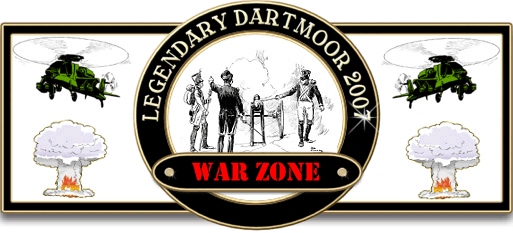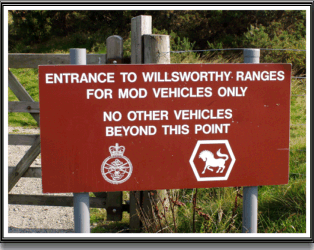
Ever since the nineteenth century the military have used Dartmoor for their exercises and manoeuvres which include live firing. The northern part of the moor is divided into three firing ranges; Okehampton, Willsworthy and Merrivale. These are all marked with lines of red and white poles most of which have warning notices on them. On days that live firing is taking place one or more of the ranges will be closed to the public. Prior to the actual firing day the Range Wardens go out and clear the firing area of livestock. Numerous red flags are flown from prominent hilltops and tors and various observation posts are manned to ensure nobody inadvertently strays into the line of fire. So one could assume that every precaution is taken to ensure the safety of the public and it cannot be denied that they usually work well.
Once the firing exercise has ended it is now normal procedure for teams of arms personnel and range wardens to sweep the area in search of unexploded ordnance. If unexploded shells, mortar rounds, grenades, or live bullets are found they are safely removed. This has not always been the case as can be seen from the list below:
1892 – This newspaper report must be one of the earliest examples of accidents on Dartmoor caused by unexploded shells:
“A serious incident occurred on Saturday morning to Sergeant Festing, of the 13th Battery Royal Artillery. The sergeant with several other men was examining a shell which had been picked up on the range, and which had, as it turned out only partially exploded. As the shell was a new invention and used experimentally, the men were eager to learn whether it was an improvement on the shells now in use, and it was taken to the blacksmith’s shop in the camp for the purpose of being investigated. A hammer was being used to open it when it exploded with tremendous force and struck Sergeant Festing in the abdomen with the shell inflicting frightful injuries. Another man had his thumbs blown off, while several shots passed through the apron he was wearing. Festing was placed on an ambulance and carried with great care to the Okehampton Railway Station, and he and the other injured man were then sent by train to Plymouth and taken to the military hospital.”
1901 – Here is another newspaper report:
“An accident of shocking character has occurred on the Dartmoor ranges of the artillery practice camp of Okehampton. George Kelly, a range attendant was making his rounds of the ranges early yesterday morning when he discovered near the summit of Yes Tor the mutilated bodies of three men. They were collected and removed to the camp on an ambulance and were identified as those of Sergeant Frank Bleakley, 96th battery R.F.A., range sergeant; Police constable Hall of the Devon Constabulary, stationed at Okehampton; and J. L. Vanstone, an ex-sergeant of police, employed as school attendance officer at Okehampton. From the appearance of the remains there was little room for doubt that the men had been blown to pieces by the explosion of a Lyddite shell. Vanstone’s hands had been blown off, and he had large wounds in the stomach and face. Police constable Hall had both arms blown away close to his body; his head was also blown off, and all the upper parts of his clothes torn away and his legs broken. Sergeant Bleakley was blown to atoms, one of his feet being picked up 200 yards away, and the only means of identifying him was by his boots…”
1942 – A young man was killed whilst ploughing a field near Widecombe-in-the-Moor when his plough struck a unexploded bomb.
1946 – A 10 year old boy was killed by an unexploded mortar round near Great Mis tor, his 12 year old friend was injured.
1948 – A boy was killed near Hexworthy by a unexploded shell.
1953 – A man was killed whilst clearing ‘military litter’ from Holming Beam.
1958 – A boy was killed near Cranmere Pool by incoming shell fire.
1964 – An officer received blister burns caused by poisonous gases from a dump found near the river Lyd.
1966 – A young boy was killed by an unexploded shell near the Forest Inn at Hexworthy.
1966 – A boy lost the fingers of one hand when he picked up a live rifle round at Mis tor.
1987 – A boy received serious injuries from what was thought to be an unexploded grenade near Okehampton.
1995 – A young girl was seriously injured by a unexploded ‘device’ and her two brothers hospitalised near Great Mis tor.

Those are some of the tragic incidences that have occurred over the years, the following could have been equally as fatal, although the image of school children with mortar shells in the classroom does appeal to my warped sense of humour:
1982 – Children found 5 unexploded mortar shells on the north moor and carried them home to Sourton.
1982 – Children from Chudleigh school carried home two unexploded shells whilst on a field trip.
1979 – A boy from Okehampton school was found to have a live mortar bomb in his rucksack after a school field trip.
There are numerous reports of various unexploded ordnance being found and disposed of by the army or navy bomb disposal teams. At one time there was a letterbox sited near Devil’s tor which used a unexploded shell as a bearing in the clue, it read: “From large unexploded shell between Rough tor and Devil’s tor outcrop go 106p on 118º to box under small rock.” Needless to say this particular shell has now been safely disposed of.
Prior to the 1995 accident on Great Mis tor, letterboxes were often placed inside old ammunition cans and then hidden. It is now against the letterboxing code to use ammo cans as young children may mistake unexploded ordnance for such containers and then pick them up which is thought to have been how the 1995 incident occurred.
There is a dedicated website which states when the live firing days are and what ranges will be effected. On the site the safety precautions in place are described as:
“Warning signals, red flags by day and red lamps by night, indicate that live firing is taking place within range boundaries, which are marked with red and white posts. When warning signals are displayed do not enter the range boundary.”
As far as finding unexploded ordnance the only advice they give is:
“Do not touch any military debris – it may be dangerous note location, mark area and inform Commandant 01837 657210 or police 08452 777444.“
A few years ago a well known letterboxer revealed that he had been driving around for months with an unexploded shell in the boot of his car. He found it whilst out walking and decided to add it to his ‘Dartmoor Military Museum’, which having seen the collection could only be described as ‘extensive’. I can also recall that he once spent the whole of one weekend driving around in a tank drivers helmet (complete with communication mike) which he had found on the moor. Apparently ‘Kelly’s Heroes’ was his favourite war film and to this day I can still see him stood up through his sun roof wearing that bloody helmet. Another walker came traipsing into the pub one night with a SLR rifle that he had found propped up against a tor. It is amazing to think that it is possible to find weaponry that spans over at least 10,000 years on Dartmoor, from flint arrowheads to rifle bullets.
But please do not get the impression that walking on Dartmoor is like hiking around Iran with bombs lying everywhere. Yes, there are still items lying in the peat but as long as they are left well alone there is no danger. It is always best to check the firing times on the moor before setting out, there is nothing worse than planning a walk, driving up and finding that your route is closed. The firing times can be found on the Dartmoor Firing Notices web page.
 Legendary Dartmoor The many aspects past and present of Dartmoor
Legendary Dartmoor The many aspects past and present of Dartmoor

1946 – A 10 year old boy was killed by an unexploded mortar round near Great Mis tor, his 12 year old friend was injured.
1948 – A boy was killed near Hexworthy by a unexploded shell.
Do you have further information on these incidents? I believe one of the boys (46 Incident) was a Brian Creed who saved the lives of his friends by crawling for help, His father was a Prison Officer and I saw him later as a young man on the Isle of Wight where both a fathers were posted after the war. Would be interested to see more detail of this awful event. David.